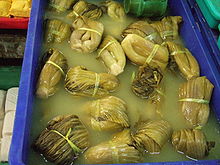Suan cai
| Suan cai | |||||||||||||||||||

A tub of Suan cai made from Chinese mustard.
|
|||||||||||||||||||
| Chinese | |||||||||||||||||||
|---|---|---|---|---|---|---|---|---|---|---|---|---|---|---|---|---|---|---|---|
| Hanyu Pinyin | suān cài | ||||||||||||||||||
| Literal meaning | sour vegetable | ||||||||||||||||||
|
|||||||||||||||||||
| Alternative Chinese name | |||||||||||||||||||
| Chinese | |||||||||||||||||||
| Literal meaning | salted vegetable | ||||||||||||||||||
|
|||||||||||||||||||
| Transcriptions | |
|---|---|
| Standard Mandarin | |
| Hanyu Pinyin | suān cài |
| Wade–Giles | suan1-ts'ai4 |
| other Mandarin | |
| Dungan | Сўан цаы |
| Yue: Cantonese | |
| Yale Romanization | syūn choi |
| Jyutping | syun1 coi3 |
| Transcriptions | |
|---|---|
| Standard Mandarin | |
| Wade–Giles | hsien2-ts'ai4 |
| other Mandarin | |
| Dungan | Щыән цаы |
| Yue: Cantonese | |
| Yale Romanization | hàahm choi |
| Southern Min | |
| Hokkien POJ | kiâm-chhài |
Suan cai (also called suan tsai and Chinese sauerkraut; literally "sour vegetable") is a traditional Chinese pickled Chinese cabbage, used for a variety of purposes. Suan cai is a unique form of pao cai, due to the ingredients used and the method of production.
An alternative name for suan cai is xian cai (hsien tsai; literally "salted vegetable").
Two distinct types of suan cai are found in China:
Production of suan cai differs from other pao cai in that the vegetable is compressed. This is accomplished by placing a heavy weight such as a large rock on top of the cover of the container so that the Chinese cabbage inside the container is slowly pressed and fermented. The processing of the vegetable helps to create a distinct flavor.
Suan cai is often used in cooking with meat, especially pork. It is said to neutralize the grease of meat.
In Chinese Islamic cuisine, suan cai can top off noodle soups, especially beef noodle soup.
In Hunan, suan cai is frequently made with ginger and chilies (typical of Hunan cuisine).
In Cantonese cuisine, it is served in a small dish, often as an appetizer, and usually free. Sometimes it can be available in mini-containers on the dining table. There are also Cantonese variations such as salted suan cai (鹹酸菜).
In Northeastern Chinese cuisine, suan cai is made from napa cabbage or head cabbage and has a taste similar to sauerkraut. As part of the cuisine in Manchuria, it is used with dumplings and boiled, or stir fried. More frequently, saun cai is used to make suan cai and pork stew.
In hot pot cuisine, it is often one of the ingredients.
...
Wikipedia
